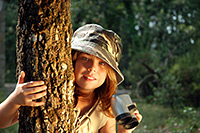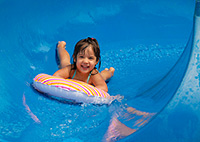The Fuji Guys Answer SavvyMom Reader Questions
 You asked and they answered. The Fuji Guys have answered a selection of SavvyMom reader questions on how to take amazing family pictures. Read on for their expert tips.
You asked and they answered. The Fuji Guys have answered a selection of SavvyMom reader questions on how to take amazing family pictures. Read on for their expert tips.How do you get the best pictures of a toddler on the move?
Katie R. from Kanata, ON
Here are some tips on taking photos of your toddler on the move.
- Let in more light
- Taking photos in brightly lit area will allow your camera to use a faster shutterspeed. This helps to reduce motion blur and allow to you freeze your toddler in action.
- It is ideal to use natural light when taking photos of your toddler. In situations where lighting is an issue, use the flash as a last resort.
- Increase the ISO or Sensitivity on the camera
- Increase the ISO setting on your camera will allow the camera to use a faster shutterspeed to capture the action. Ideally, ISO 400 or 800 is required for shooting indoors.
- Try to achieve a shutterspeed of at least 1/100 of a sec.
- Decrease the delay in shooting
- Change the auto focus on your camera to the “continuous” auto focus option if available. This will decrease the delay in capturing the right moment when you press down on the shutter.
- Pre-focus by half-pressing down on the shutter to decrease will help you reduce any delay in shooting
- Shoot in the continuous shooting mode
- Change the shooting mode on the camera to the “continuous” shooting if available. This mode will take multiple rapid shoots in succession giving you a great chance to capture the little one in action.
- Anticipate the toddler’s next move
- With your cameras settings set correctly and the focus locked (half-press shutter), call out to the toddler and just as they do their thing, take the photo
- Shoot the toddler in their nature environment.
- Don’t stop shooting
- The more photos you take, the more chances you will have a “keeper”
What’s the best method to help people with light colored eyes avoid getting red eyes in photos?
Tanya B. from Thornhill, ON
There are several ways to help reduce / eliminate red-eye in photos:
- Don’t use the flash. Red-eye is caused by the flash reflecting in the eye and back through the pupil.
- Have the subject close their eyes for a few seconds before taking the photo.
- Use an external flash. The further the flash is away from the cameras lens, the less likely red-eye will appear. Red-eye tends to happen when the flash and the lens are in close proximity to each other, hence it happens more frequent with compact cameras.
- Use the “Red Eye” reduction flash mode. The camera fires a pre-flash prior to taking the photo. This makes the pupil in the eye dilate to reduce the likeliness of the “red eye” effect.
- Enable Auto Red-Eye Removal. In most Fujifilm cameras, this feature automatically detects any red-eye in an image captured and removes is automatically.
 What’s the best way to get a great family portrait?
What’s the best way to get a great family portrait?
Laura D. from Victoria, BC
- Choose the right outfit
- Select neutral colour outfits as they will put more focus on the people and their faces versus the clothing.
- Don’t outdate the photo by wearing something too flashy.
- Avoid extreme colours, prints, patterns, and logo.
- Decide on the clothing before the day you would like to take the photo’s
- Subject positioning
- It’s a family portrait so don’t be afraid to get close to each other. This gives a better sense of warm and comfort.
- Refrain from anyone tilting their head on a family member’s shoulder
- Location
- Choose a good location where you can get a little natural light coming into the photo
- A location that has importance to the family is ideal. If the family likes to sail, setup the portrait at the docks or on the deck of the sail boat. If the family enjoys the outdoors, take it at the park.
- Have the correct camera settings
- Try to shoot with a wide-open aperture on your camera to allow the background to be “blurred” giving you a shallow depth of field. Unlike DSLR cameras, it may be very difficult to get the background out of focus with a compact camera even if the camera has manual controls.
- If you are shooting outdoors with good lighting, you may still need to force the flash to remove any unwanted shadows in the face.
- Have the right equipment
- Use a tripod to ensure you get a steady and leveled photo
- Use an external flash if possible. Aim/bounce the flash towards the ceiling to help soften the effects of the flash on the subject’s face when shooting indoors.
 What time of the day is the best to take great pictures of my family?
What time of the day is the best to take great pictures of my family?
Margaret I. from Toronto, ON
High noon is not ideal when shooting outdoors as the lighting may be too harsh. Ideally, the best time of day is in the morning or just before dusk. Of course, taking the photos when the kids are the happiest helps too.
What are the best colours to wear for taking great family pictures?
Zaheeda from Brampton, ON
- Select neutral colour outfits as they will put more focus on the people and their faces versus the clothing.
- Don’t outdate the photo by wearing something too flashy.
- Avoid extreme colours, prints, patterns, and logo.
- Avoid bright reds and oranges. These colours overpower the faces in the photo.
- Wear complimentary colours.
- Dress casually. The best family pictures come out when everyone feels comfortable in what they are wearing.
 How do I get good action shots of the kids jumping in the pool or playing sports? I always seem to miss the mid-air/mid-play shots and end up with half a kid lost in the splash, or missing the kick.
How do I get good action shots of the kids jumping in the pool or playing sports? I always seem to miss the mid-air/mid-play shots and end up with half a kid lost in the splash, or missing the kick.
Sue B. from Chesterville, ON
Following the same rules that apply to Question #1 will help with good action shots.
- Continuous Shooting Mode
- Change the shooting mode on the camera to the “continuous” shooting if available. This mode will take multiple rapid shoots in succession giving you a great chance to capture the kids in action.
- Increase the shutterspeed to freeze the action
- Try to use a very fast shutterspeed to freeze the action. Most cameras have a “Sports” mode which will utilize the fastest shutterspeed possible (dependant on available lighting) to freeze the subject in action.
- If your camera has a “Shutterspeed Priority” mode, use this to increase the shutterspeed.
- Increasing the ISO/sensitivity on the camera will also allow you to use a faster shutterspeed when lighting is not ideal.
- Ideally 1/160s or faster will freeze the splash of water in mid air.
- Decrease the delay in shooting
- Change the auto focus on your camera to the “continuous” auto focus option if available. This will decrease the delay in capturing the right moment when you press down on the shutter.
- Pre-focus by half-pressing down on the shutter to decrease will help you reduce any delay in shooting
How do I eliminate the glare of the water when taking pictures of my kids in the pool?
Tracy M. from Hamilton, ON
- Avoid the use of the flash when taking photos at the pool side.
- Adjusting the exposure of the camera by changing the exposure compensation value on the camera can help to reduce glare in the pool.
- If your camera has the ability to attach filters to the front of the lens, the use of a polarizing filter can effectively reduce glare.
I envy people who can take the most gorgeous sunset shots. What is the best time (golden hour) and best way to get such beautiful sunsets for when I go on my next vacation?
Marie C. from Montreal, QC
The sun sets at different times throughout the year. Knowing when the sun sets in your area is your best bet to taking great photos. Even as the sun sinks beneath the horizon, you can still obtain amazing colours (sometimes even 15 minutes after the sun as set). Ideally, be ready to shoot at your preferred location 30 minutes before and after the sun has set.
On most Fujifilm cameras, there is a “Sunset” mode within the “Scene Position” dial which has optimal settings for taking sunset photos. I highly recommend the use of a tripod for any sunset photos. If you camera does not have a “Sunset” mode, you may try the following settings;
- Set ISO/Sensitivity on your camera to the lowest possible setting (100 ISO)
- Play around with your white balance settings. Sometimes “Auto” white balance will give you too warm of a photo. Try using the “Shade” setting.
- Have the camera on a tripod and use the self-timer to prevent any camera shake.
- Play around with the “Exposure Compensation” feature of your camera to adjust the exposure (Making it brighter or darker).
Some of our favorite summer moments are spent beside a campfire. How can you take better pictures in dim light or without the campfire smoke obscuring the shot?
Amanda P. from Calgary, AB
I would recommend turning the flash off on the camera and using a slow shutterspeed to capture the campfire scene. Ensure you have a tripod and don’t forget to use the self-timer regardless if you are in the photo or not to prevent any camera shake. Have the subjects stay very still. Typically, you want to play with the shutterspeed on the camera until you get a good exposure. Typically a 1 sec exposure or slower using ISO 200 or lower will give you a great exposure.
- Set the ISO/Sensitivity on your camera to ISO 400 or lower.
- Disable the flash (No Flash)
- Set the camera on a tripod
- Either set the camera to a Night Scene mode which allows for long exposure or if your camera has manual settings, adjust the shutterspeed to be very slow.
- Have everyone in the photo sit/stay perfectly still even after you here the camera click. (Hold still for 3 seconds to be safe)
What is the best camera to buy?
Pat G. from Edmonton, AB
The best camera to buy is the one you will use the most! Make sure to purchase a camera that feels comfortable in your hands, and is relatively simple for you to use. Typically, cameras over $200 should give you excellent pictures for years to come.













